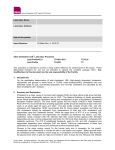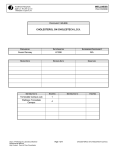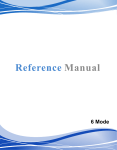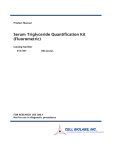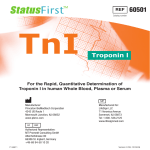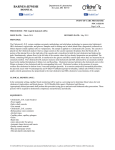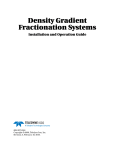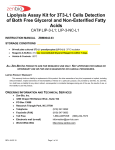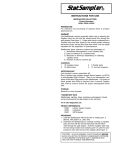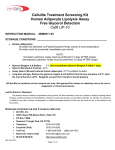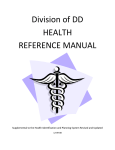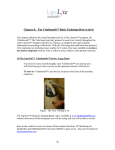Download CHO-03-034 TCI-Lip-Glu_1
Transcript
and hydrogen peroxide. In a reaction catalyzed by horseradish peroxidase, the peroxide reacts with 4-Aminoantipyrine and N-Ethyl-N-sulfohydroxypropyl-m-toluidine, sodium salt (TOOS) to form a purple-colored quinoneimine dye proportional to the total cholesterol and HDL cholesterol concentrations of the sample. Cholesterol esterase LIPID PROFILE·GLU Cholesterol esters + H2O Total Cholesterol, HDL Cholesterol, Triglycerides and Glucose Panel Test Cassette Cholesterol + O2 CLIA-WAIVED —These tests are waived under CLIA ’88 regulations. If a laboratory modifies the test system instructions, then the test is considered highly complex and subject to all CLIA requirements. IVD For professional in vitro diagnostic use. Cholesterol oxidase Introduction Cholesterol is a major cause of coronary heart disease (CHD), and large clinical trials show that lipid-lowering therapy substantially reduces risk for CHD.1 The National Institutes of Health periodically issues clinical guidelines for cholesterol testing and management as part of the National Cholesterol Education Program (NCEP). The most recent update, the third report of NCEP’s Adult Treatment Panel (ATP III), recommended that a fasting lipoprotein profile should be obtained at least every five years in all adults aged 20 years and older.1 This lipid profile consists of total, HDL, and LDL cholesterol and triglycerides. NCEP recommends that for routine patient evaluation and follow-up, LDL cholesterol should be estimated from measurement of total and HDL cholesterol and triglycerides using the Friedewald formula.2 While the major focus of ATP III is on lowering LDL cholesterol, HDL cholesterol and triglycerides are identified as significant risk factors. Low HDL cholesterol values increase CHD risk whereas high HDL values protect against CHD. Elevated triglycerides are also a strong independent risk factor for CHD most often observed in individuals with metabolic syndrome. The ATP III established therapeutic goals for LDL and HDL cholesterol and triglycerides depending upon individual CHD risk factors. Follow-up measurement of these lipid parameters is necessary to ensure that individuals achieve treatment goals. Glucose is the major energy source for the human body and is necessary for the growth, development and maintenance of virtually all cells in the tissues and organs.3 Blood glucose levels are maintained within a relatively narrow range by a combination of interacting factors that decrease the glucose level when it gets too high and increase it when it drops too low. Because this delicate homeostatic mechanism is able to keep glucose levels within such a narrow range, values outside this range generally indicate a disease state. Insulin is the principal hormone regulating glucose levels, and any defect in the production or action of insulin can lead to one of the several forms of diabetes mellitus. Persons with diabetes mellitus may develop a number of serious complications, and some studies have shown that careful control of blood glucose levels may reduce the incidence or delay the onset of these complications. Total cholesterol, HDL cholesterol, triglycerides and glucose can be measured simultaneously from a single drop of blood using the Cholestech LDX System’s rapid, accurate technology. Estimated LDL cholesterol and VLDL cholesterol and a TC/HDL ratio are calculated using the measured values. Test Principle The Cholestech LDX System combines enzymatic methodology4 and solid-phase technology to measure total cholesterol, HDL cholesterol, triglycerides and glucose. Samples used for testing can be whole blood from a fingerstick (collected in a lithium heparin-coated capillary tube) or venipuncture. The sample is applied to a Cholestech LDX cassette. The cassette is then placed into the Cholestech LDX Analyzer where a unique system on the cassette separates the plasma from the blood cells. A portion of the plasma flows to the right side of the cassette and is transferred to both the total cholesterol and triglyceride reaction pads. Simultaneously, plasma flows to the left side of the cassette where the low-density lipoproteins (LDL and VLDL) are precipitated with dextran sulfate (50,000 MW) and magnesium acetate precipitating reagent.5 The filtrate, containing both glucose and HDL cholesterol, is transferred to both the glucose and HDL cholesterol reaction pads. The Cholestech LDX Analyzer measures total cholesterol and HDL cholesterol by an enzymatic method based on the method formulation of Allain et al,6 and Roeschlau.7 Cholesterol esterase hydrolyzes the cholesterol esters in the filtrate or plasma to free cholesterol and the corresponding fatty acid. Cholesterol oxidase, in the presence of oxygen, oxidizes free cholesterol to cholest-4-ene-3-one 1. 2. Let cassette sit at room temperature for 10 minutes. Remove the cassette from its pouch. Do not touch the black bar or the brown stripe. Put the cassette on a flat surface. Cassettes may be used until the date printed on the pouch when stored in a refrigerator (36 – 46ºF / 2– 8ºC). Or the cassettes may be stored for up to 30 days at room temperature (less than 86°F / 30°C). NOTE: Gloves should be worn when working with blood samples. • 3. Cholest-4-ene-3-one + H2O2 Peroxidase 2 H2O2 + 4-Aminoantipyrine + TOOS Quinoneimine dye + 4 H2O The Cholestech LDX Analyzer measures triglycerides by an enzymatic method based on the hydrolysis of triglycerides by lipase to glycerol and free fatty acids. Glycerol, in a reaction catalyzed by glycerol kinase, is converted to glycerol-3-phosphate. In a third reaction, glycerol-3-phosphate is oxidized by glycerol phosphate oxidase to dihydroxyacetone phosphate and hydrogen peroxide.8 The color reaction utilizing horseradish peroxidase is the same as for the total cholesterol and HDL cholesterol. Triglycerides + H2O Glycerol + Free fatty acids Glycerol kinase + Mg2+ Glycerol-3-phosphate + ADP Glycerol + ATP Glycerol phosphate Glycerol-3-phosphate + O2 • • • Oxidase Dihydroxyacetone phosphate + H2O2 Peroxidase 2 H2O2 + 4-Aminoantipyrine + TOOS Quinoneimine dye + 4 H2O The Cholestech LDX Analyzer measures glucose by an enzymatic method that uses glucose oxidase to catalyze the oxidation of glucose to gluconolactone and hydrogen peroxide. The color reaction utilizing horseradish peroxidase is the same as that for total cholesterol, HDL cholesterol and triglycerides. The resultant color in all the reactions is measured by reflectance photometry. Glucose oxidase Selftest OK 4. Please Note: The Cholestech LDX System is CLIA-waived for fingerstick or venous whole blood unprocessed samples only. If you run serum or plasma on the Cholestech LDX, you will be classified as moderately complex and will have to comply with the regulations for moderate complexity. See the Cholestech LDX System User Manual for a summary of these regulations. 2 H2O2 + 4-Aminoantipyrine + TOOS Quinoneimine dye + 4 H2O Fingerstick whole blood: • Collect the sample from a fingerstick into a Cholestech LDX Capillary Tube. (See the Fingerstick Procedure in the Cholestech LDX System User Manual). Place the blood into the cassette within 5 minutes of collection. Blood from the fingerstick should flow freely. Too much squeezing of the finger may cause poor results. LIPID PROFILE·GLU Total Cholesterol, HDL Cholesterol, Triglycerides and Glucose Panel Cassette Each Lipid Profile·GLU cassette contains a minimum of: PRECAUTION: All blood samples and containers, capillary tubes and materials that have come in contact with blood should be handled as if capable of transmitting infectious disease and discarded into a biohazard waste container after use. TC – HDL 8.9 TRG – GLU – – 0.34 79.5 0.34 – – – – No calibration is done by the user. Test information is on the brown stripe of the cassette. The brown stripe is read by the Cholestech LDX each time a cassette is run. An optics check should be done on the Analyzer each day. See the Cholestech LDX System User Manual for instructions. Calibration – – 80 – 0.058 0.058 – – 0.32 6.4 92.0 0.32 3.0 19.3 0.16 3.3 19.2 0.16 6.08 38.6 TEST PROCEDURE – – 0.48 – Lipid Profile·GLU cassettes Additional Materials Required: – – – – 22.4 Materials Provided: 0.64 – – – 0.29 – – – 0.76 – Nonreactive ingredients: Buffers and stabilizers 6. 7. Collect blood into a green-top tube (heparin anticoagulant). Use a MiniPet™ Pipette and tip to place blood into the cassette. Whole blood should be used within 30 minutes. Samples should be at room temperature for testing. Mix all samples by inverting gently 7– 8 times before testing. Glucose levels decrease 5 to 10 mg/dL per hour in whole blood at room temperature. • • • • • • • • • • Cholestech LDX Analyzer and power supply Alcohol swabs and gauze for cleaning puncture site Lancets for capillary blood collection Cholestech LDX Capillary Tubes (with lithium heparin anticoagulant) Cholestech LDX Capillary Plungers Gloves Biohazard waste containers Quality control material MiniPet Pipette and tips or micropipetter that will deliver 35 – 50 µL for use with venipuncture samples and quality control material Vacuum collection tubes, needles and tube holders if sample is to be collected by venipuncture Place the sample into the cassette well. Use a Cholestech LDX Capillary Tube for fingerstick samples. Use the MiniPet Pipette for controls or venous blood samples. NOTE: Fingerstick samples must be applied within five (5) minutes or the blood will clot. Keep the cassette flat after the sample has been applied. Place the cassette into the drawer of the Analyzer at once. The black bar must face the Analyzer. The brown stripe must be on the right. Press RUN. The drawer will close. During the test the screen will read: [Test Name(s)] Test Running*** NOTE: Do not use a tube with any other additives because it may cause poor results. • • • • • – 5. Venous whole blood: • A brown (magnetic) stripe on each cassette contains the calibration information required for the Cholestech LDX Analyzer to convert the reflectance reading (% R) to the total cholesterol, HDL cholesterol, triglycerides and glucose concentrations in mg/dL. Sample Volume: 35 – 50 µL of whole blood. The subject should fast for 12 hours before the sample is collected. The cassette drawer will open. The screen will read: Load cassette and press RUN Sample Handling • • QUALITY CONTROL Quality control should be run routinely to show that your system is giving accurate results. We recommend the following quality control procedures for the Cholestech LDX System. Choice of Materials A high and a low control for each analyte is preferred. Cholestech-recommended controls work well with the Cholestech LDX System. If you use other controls, you will need to set ranges for the Cholestech LDX System. Handling Cassettes should sit at room temperature for 10 minutes before opening pouch. Use the cassette as soon as the pouch is opened. o-D-gluconolactone + H2O2 Peroxidase Press RUN. In a few seconds the screen will read: Selftest running. Cassette Handling • • Glucose + O2 Dextran sulfate (50,000 M.W.), µg Magnesium acetate, µg Cholesterol esterase, U (Pseudomonas species) Lipase (Bacterial source) Cholesterol oxidase, U (Pseudomonas species) Peroxidase (horseradish), U 4-Aminoantipyrine, µg N-Ethyl-N-sulfohydroxypropylm-toluidine, sodium salt, µg Glycerol kinase, U (Cellulomonas species) Glucose oxidase, U (Cellulomonas species) Adenosine triphosphate, µg (Equine muscle, disodium form) Glycerol phosphate oxidase, U (Aerococcus viridans) Magnesium chloride, µg Once cassettes have been stored at room temperature, they should not be returned to the refrigerator. Do not use a cassette beyond the printed expiration date. Do not use a cassette that has been stored at room temperature for more than 30 days. Do not reuse cassettes. Sample Type Lipase Indications For Use: Running a Test Cassettes must be stored in the sealed foil pouches. Free cholesterol + Fatty acids Catalog No. 10-991 For the quantitative determination of total cholesterol, HDL (high-density lipoprotein) cholesterol, triglycerides and glucose in whole blood. A TC/HDL (total cholesterol/HDL cholesterol) ratio and estimated values for LDL (low-density lipoprotein) and VLDL (very low-density lipoprotein) cholesterol are calculated by the Cholestech LDX. Cassette Storage and Stability 8. 9. Put everything that touched the blood sample or control in a biohazard waste container. When the test is complete, the Analyzer will beep. The screen will read: [Test Name(s)]=### warnings • • • Follow the instructions that come with your controls. Check the expiration date before use. Do not use if expired. See “Running a Test” for procedure. External Quality Control External controls must also be used to demonstrate that the reagents and the assay procedure perform properly. Liquid Lipid/Glucose Level 1 and Level 2 Controls are available from Cholestech. Controls must be tested: • • • • With each new shipment of cassettes (even if cassettes are from the same lot previously received). With each new lot of cassettes. As otherwise required by your laboratory’s standard quality control procedures. If you are not running the Cholestech LDX under CLIA-waived status, or if your local or state regulations require more frequent testing of quality control material, then quality control must be performed in compliance with those regulations. Good Laboratory Practice principles suggest that external controls must be run whenever the laboratory director has any question about test system integrity or operator technique (e.g., when reagents may have been stored or handled in a way that can degrade their performance or when operators have not performed a particular test in recent weeks). If the controls do not perform as expected, repeat the test or contact Cholestech Technical Service before testing patient samples. The quality control results must be in range before testing patient samples. See the Cholestech LDX System User Manual if they are not. Please call Cholestech Technical Service at 800-733-0404 if you have any questions about quality control. RESULTS Test results will show on the screen when the test is complete. Calculated results are shown after the DATA button is pressed. To convert: 10. Press DATA to show more results. 11. When the results are outside the measuring range, the screen will read: [Test Name]>### or [Test Name]<### 12. If there is a problem with the test, a message will appear on the screen. See the Cholestech LDX System User Manual if this happens. 13. When the drawer opens, remove the cassette. Put it in a biohazard waste container. Leave the Analyzer drawer empty when not in use. 14. Record the results. 15. To run another cassette, press RUN. The screen will read: Load cassette and press RUN TC HDL TRG GLU System timeout RUN to continue If the RUN button is not pushed within 15 seconds, the drawer will close. Then the screen will go blank. mmol/L to mg/dL multiply mmol/L by 38.664 38.664 88.54 18.018 LIMITATIONS • • • • 16. Repeat the test procedure. 17. Otherwise, after 4 minutes a beep will sound and the screen will read: mg/dL to mmol/L divide mg/dL by 38.664 38.664 88.54 18.018 • • • • • • • The measuring range for total cholesterol is 100 – 500 mg/dL. Results outside this range will appear as <100 mg/dL or >500 mg/dL. The measuring range for HDL cholesterol is 15 –100 mg/dL. Results outside this range will appear as <15 mg/dL or >100 mg/dL. The measuring range for triglycerides is 45 – 650 mg/dL. Results outside this range will appear as <45 mg/dL or >650 mg/dL. The measuring range for glucose is 50 – 500 mg/dL. Results outside this range will appear as <50 mg/dL or >500 mg/dL. If the triglycerides are >400 mg/dL, the estimated LDL will not be calculated. If the total cholesterol, HDL cholesterol or triglyceride result is outside the measuring range, the LDL will appear as N/A. If the triglycerides are >650, the HDL result may not be accurate and will appear as N/A. The glucose test is specific for D-glucose. Other sugars that may be present in the blood do not react in the glucose test (i.e., fructose, lactose). Samples with total cholesterol, HDL cholesterol, triglyceride or glucose values outside the measuring range should be sent to a laboratory for testing. Performance of the Cholestech LDX System has not been tested on samples from newborns. Glucose tests done at altitudes above 5,000 feet may give low results. Some substances may cause false results with enzymatic tests. The substances listed below were tested for all analytes. Less than 10% interference was seen at the levels shown. Glucose: Substance Concentration (mg/dL) FPG <110 mg/dL FPG 110 and <126 mg/dL FPG 126 mg/dL Hemoglobin L-Dopa Ascorbic Acid Urea Fructose Uric Acid Creatinine Glutathione Cimetidine Oxytetracycline Lactose Cysteine • • • • • 125 0.8 1 500 30 15 30 1 7.5 4 100 2.5 Gemfibrozil Bilirubin Probucol Nicotinic Acid Clofibrate Lovastatin Dipyrone Methotrexate Nitrofurantoin Gentisic Acid Methyldopamine 15 5 32.5 10 80 4 10 450 2 0.5 0.5 Normal fasting glucose Intermediate fasting glucose Provisional diagnosis of diabetes confirmed by one of the three methods below The revised criteria for diagnosis of diabetes: • • • Hematocrits between 30% and 52% do not affect results. Blood collection tubes with glycerol should not be used for the triglyceride test. Hand creams and soaps with glycerol may cause falsely high triglyceride results. The triglyceride test measures triglycerides and free glycerol. Free glycerol usually is less than 20 mg/dL.9,10 There may be a 6 –7% difference in the glucose levels of fingerstick and venous blood.11 Glucose: The American Diabetes Association has modified the criteria for fasting plasma glucose (FPG) and the diagnosis of diabetes mellitus.14 Symptoms of diabetes plus casual plasma glucose concentration 200 mg/dL (11.1 mmol/L). Casual is defined as any time of day without regard to time since last meal. (The classic symptoms of diabetes include polyuria, polydipsia, and unexplained weight loss.) FPG >126 mg/dL (7.0 mmol/L). Fasting is defined as no caloric intake for at least 8 hours. 2 hr. post glucose load 200 mg/dL during an oral glucose tolerance test. The test should be performed as described by WHO (World Health Organization) using a glucose load containing the equivalent of 75-g anhydrous glucose dissolved in water. Any of the above abnormal glucose levels must be confirmed, on a subsequent day, by any one of the three methods listed above. When screening for diabetes, any abnormal glucose result should be referred to a physician for further follow-up. Performance Characteristics Total Cholesterol: EXPECTED VALUES Cholesterol and Triglycerides: The National Heart, Lung and Blood Institute issued the Third Report of the National Cholesterol Education Program (NCEP) Expert Panel on Detection, Evaluation, and Treatment of High Blood Cholesterol in Adults (Adult Treatment Panel III) in May 2001.1 The ATP III report presented the NCEP’s updated clinical guidelines for cholesterol testing and management and described the following classifications for cholesterol and trigylceride testing: mg/dL (mmol/L) Classification <100 100 –129 130 –159 160 –189 ≥190 (<2.59) (2.59 –3.34) (3.36 – 4.11) (4.14 – 4.89) (≥4.91) Optimal Near optimal/above optimal Borderline high High Very high ≥ 240 <200 200 –239 (<5.18) (5.18 – 6.19) (≥6.22) Desirable Borderline high High <40 ≥60 (<1.03) ( ≥1.55) Low High <150 150 –199 200 – 499 ≥ 500 (<1.69) (1.69 –2.25) (2.26 –5.64) ( ≥5.65) Normal Borderline high High Very high LDL cholesterol Total cholesterol Within-Run Precision n= – X (mg/dL) = SD (mg/dL) = CV (%) = Whole Blood (heparin) Level 1 Level 2 10 10 184 299 4.6 7.3 2.5 2.4 Day-to-Day Precision n= – X (mg/dL) = SD (mg/dL) = CV (%) = Commercial Control Material Level 1 Level 2 20 20 161 244 4.3 8.6 2.7 3.5 HDL Cholesterol: Within-Run Precision n= – X (mg/dL) = SD (mg/dL) = CV (%) = Whole Blood (heparin) Level 1 Level 2 10 10 29 46 1.0 2.2 3.4 4.8 Day-to-Day Precision n= – X (mg/dL) = SD (mg/dL) = CV (%) = Commercial Control Material Level 1 Level 2 20 20 29 46 1.3 2.9 4.5 6.3 HDL cholesterol Triglycerides The ATP III identified HDL cholesterol levels below 40 mg/dL (1.03 mmol/L) as associated with increased risk of coronary heart disease (CHD) in men and women.1 A high HDL cholesterol level greater than or equal to 60 mg/dL (1.55 mmol/L) is protective and decreases CHD risk. TC/HDL Ratio: The ATP III report does not comment on use of the ratio of total to HDL cholesterol. Various authors have suggested that the TC/HDL ratio is the strongest lipid risk factor and can be a useful summary of CHD risk.12,13 A ratio of 4.5 or less is desirable. A ratio greater than 6.0 suggests a high risk of CHD.12 Triglycerides: Within-Run Precision n= – X (mg/dL) = SD (mg/dL) = CV (%) = Whole Blood (heparin) Level 1 Level 2 10 10 256 362 4.0 13.1 1.6 3.6 Day-to-Day Precision n= – X (mg/dL) = SD (mg/dL) = CV (%) = Commercial Control Material Level 1 Level 2 20 20 121 276 2.8 8.7 2.3 3.2 Within-Run Precision n= – X (mg/dL) = SD (mg/dL) = CV (%) = Whole Blood (heparin) Level 1 Level 2 10 10 103 127 6.4 5.7 6.2 4.5 Day-to-Day Precision n= – X (mg/dL) = SD (mg/dL) = CV (%) = Commercial Control Material Level 1 Level 2 20 20 103 311 3.6 15.4 3.5 5.0 LDL Cholesterol: Results: X = Reference Method (serum) Y = Cholestech LDX Analyzer (venous whole blood) Analyte Total cholesterol HDL cholesterol Triglycerides Glucose Within-Run Precision n= – X (mg/dL) = SD (mg/dL) = CV (%) = Day-to-Day Precision n= – X (mg/dL) = SD (mg/dL) = CV (%) = Commercial Control Material Level 1 Level 2 20 20 108 143 4.6 8.4 4.3 5.9 1. 3. 4. 5. 6. 7. 8. VLDL Cholesterol: 9. Within-Run Precision n= – X (mg/dL) = SD (mg/dL) = CV (%) = Whole Blood (heparin) Level 1 Level 2 10 10 51 72 0.8 2.6 1.6 3.6 Day-to-Day Precision n= – X (mg/dL) = SD (mg/dL) = CV (%) = Commercial Control Material Level 1 Level 2 20 20 24 55 0.6 1.7 2.5 3.1 Slope 0.98 0.97 1.0 0.99 y-intercept 2.41 0.23 0.13 1.01 Correlation Coefficient 0.97 0.95 0.99 0.98 Bias at 200 –1% 35 –2% 250 0% 150 0% References 2. Whole Blood (heparin) Level 1 Level 2 10 10 87 197 4.3 7.5 4.9 3.8 No. of Pairs 40 40 40 40 10. 11. 12. 13. 14. Expert Panel on Detection, Evaluation, and Treatment of High Cholesterol in Adults. Executive summary of the Third Report of the National Cholesterol Education Program (NCEP) Expert Panel on Detection, Evaluation, and Treatment of High Cholesterol in Adults (Adult Treatment Panel III). JAMA 2001; 285:2486 – 97. Bachorik PS, Ross JW, for the National Cholesterol Education Program Working Group on Lipoprotein Measurement. National Cholesterol Education Program recommendations for measurement of low-density lipoprotein cholesterol: executive summary. Clin Chem 1995; 41:1414 – 20. Tietz NW, ed. Fundamentals of Clinical Chemistry. Philadelphia, Pa: WB Saunders Co; 1987. Siedel J, et al. Reagent for the enzymatic determination of serum total cholesterol with improved lipolytic efficiency. Clin Chem 1983; 29:1075 – 80. Warnick GR, Benderson J, Albers JJ. Dextran sulfate-Mg2+ precipitation procedure for quantitation of high density-lipoprotein cholesterol. Selected Methods for Clinical Chemistry 1983; 10:91– 9. Allain CC, Poon LS, Chan CSG, et al. Enzymatic determination of total serum cholesterol. Clin Chem 1974; 20:470 –5. Roeschlau P, Bernt E, Gruber W. Enzymatische bestimmung des gesamtcholesterins im serum. Z Klin Chem Klin Biochem 1974; 12:226. Fossati P, Prencipe L. Serum triglycerides determined colorimetrically with an enzyme that produces hydrogen peroxide. Clin Chem 1982; 28:2077– 80. Jessen RH, Dass CJ, Eckfeldt JH. Do enzymatic analyses of serum triglycerides really need blanking for free glycerol? Clin Chem 1990; 36:1372– 5. Tietz NW, ed. Clinical Guide to Laboratory Tests. 2nd ed. Philadelphia, Pa: WB Saunders Co; 1990. Blumenfeld TA, Hertelendy WG, Ford SH. Simultaneously obtained skin-puncture serum, skin-puncture plasma, and venous serum compared, and effects of warming the skin before puncture. Clin Chem 1977; 23/9:1705 –10. Castelli WP, Abbott RD, McNamara PM. Summary estimates of cholesterol used to predict coronary heart disease. Circulation 1983; 67:730 – 4. Kinosian B, Glick H, Garland G. Cholesterol and coronary heart disease: predicting risks by levels and ratios. Ann Intern Med 1994; 121:641–7. Report of the Expert Committee on the Diagnosis and Classification of Diabetes Mellitus. Diabetes Care 1997; 20:1183 – 97. Accuracy (Method Comparison): The Lipid Profile·GLU cassette total cholesterol was compared with a validated method traceable to the CDC-modified Abell-Kendall reference method traceable to National Institute of Standards and Technology (NIST) standards. IVD In vitro diagnostic medical device The Lipid Profile·GLU cassette HDL cholesterol was compared with a validated method, utilizing dextran sulfate/magnesium chloride precipitation and enzymatic cholesterol determination. The HDL cholesterol comparison method is based on the selected method for HDL cholesterol5 and has documented agreement with the CDC Reference Method. Catalog number The Lipid Profile·GLU cassette triglyceride test was compared with a validated method, utilizing hydrolysis with lipase. The comparison method has documented agreement with a CDC Reference Method. Single use The Lipid Profile·GLU cassette glucose was compared with a hexokinase reference method. The Lipid Profile·GLU cassette estimated LDL cholesterol was compared to that calculated from the above validated total cholesterol, HDL cholesterol and triglyceride methods. Attention. See instructions for use Do not use if package is damaged or open Lot number Use by: 3347 Investment Blvd. Hayward, CA 94545 U.S.A. Tel 800 733.0404 Fax 510 732.7227 www.cholestech.com The range of values tested (mg/dL) were as follows: TC HDL TRG GLU 120 –300 26 – 85 40 – 500 25 – 575 Authorized Representative AR-MED Ltd Runnymede Malthouse Egham TW20 9BD United Kingdom Cholestech LDX is a registered trademark of Cholestech Corporation. MiniPet is a trademark of TriContinent Scientific, Inc. © 2003 Cholestech Corporation. 402 12314 Rev. C



